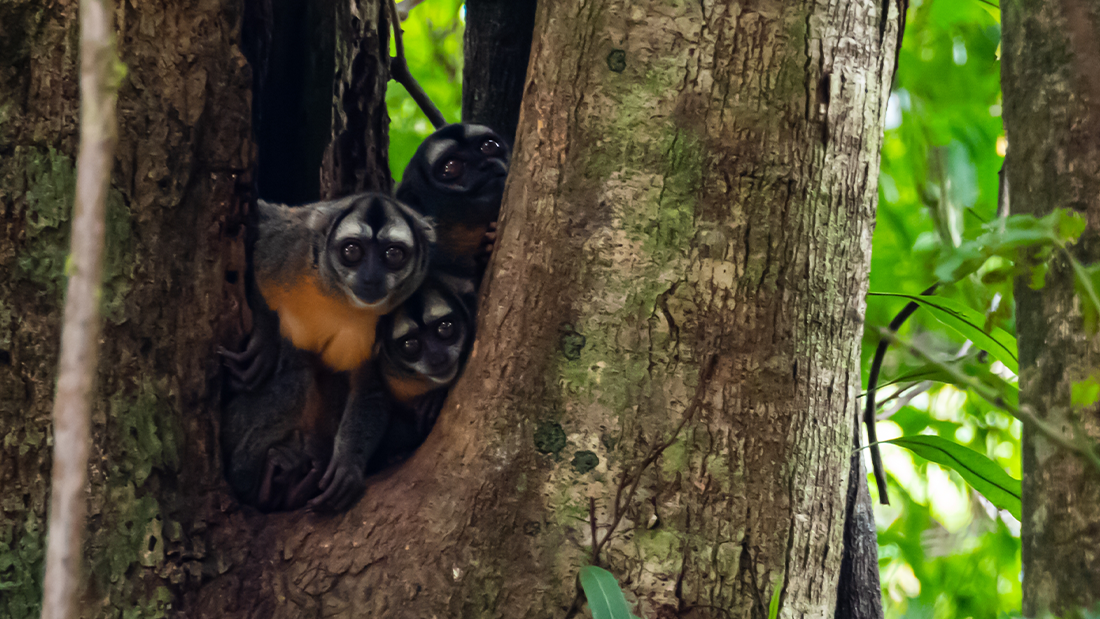Just once in a while, zoologists like to combine the names of animals – something like the parrotfish or the dragonfly. This time, they’ve done it for good reason. Meet the owl monkey, also known as the night monkey, the world’s only nocturnal primate species.
What is an owl monkey and where do they live?
The owl monkeys are a group of 10 species in the genus Aotus, split into two groups. Previously the genus just contained one species with several subspecies, but all have since been elevated to species level; however, there remains some discussion around the taxonomy. The two groups are the gray-necked, which are found north of the Amazon River, and the red-necked that are found south of the Amazon, according to the Wisconsin National Primate Research Center.
All the owl monkey species live in South America with the species having different distributions and sometimes occurring in very different tree-based habitats. Azara’s night monkey (Aotus azarae) lives in the Gran Chaco region of South America, according to the New England Primate Conservancy. The Colombian night monkey (Aotus lemurinus) is known by a host of other common names and is found in the countries of Colombia, Ecuador, and Venezuela.

Owl monkeys have incredibly tight social bonds and have never been found to cheat on their partners.
Image credit: Nowaczyk/Shutterstock.com
Owl monkeys weigh roughly 1 kilogram (2.2 pounds) and have thick gray fur across most of their bodies with orange fur over their chests and bellies, depending on the species. The standout feature of these owl monkeys is their unusually large eyes, which evolved in response to a nocturnal lifestyle – they are the only new world monkeys to be active at night. The lens of the eyes is more spherical than in monkey species that are active during the day, a chapter on nonhuman primates in the third edition of Laboratory Animal Medicine suggests.
Most species of owl monkey live in pairs or in small family groups. “Male and female owl monkeys establish pairs, forming very emotionally strong and enduring relationships. Our research indicates that they are also genetically monogamous, they only reproduce with each other,” said biological anthropologist Professor Eduardo Fernandez-Duque in an interview for Yale News.
Owl monkey fathers are heavily involved in the raising of the offspring, and actively guard their females against other males mating with them, according to a 2010 study.
“Owl monkeys are one of the few mammals where we have absolutely no evidence of unfaithfulness; there’s not a single genetic data point that suggests that males and females in pair relationships – who sleep together, feed together, move together – are not exclusively mating with each other,” continued Fernandez-Duque.
Data is limited for some areas of owl monkey ecology, but it is suggested that the male and female monkeys are the same size and have a lifespan of around 20 years in captivity, and one observed individual was found to be 11 years old in the wild.
What does an owl monkey eat?
The gray-handed night monkey (Aotus griseimembra) lives in family groups that forage at night. They eat fruit, flowers, seeds, and insects, occasionally also eating bird eggs and small birds according to the New England Primate Conservancy.
A note on biomedical research
Owl monkeys have been studied as animal models for use in vaccine research for malaria, since they are susceptible to the parasite that causes this disease in humans. They’ve even been used for research and then returned to the wild. Sometimes their nests are destroyed in the trapping process, which could damage owl monkey populations long term, writes the IUCN.
“After subjecting them to research procedures, the monkeys are released back into the wild without follow-up, which is possibly causing the displacement or hybridization of resident populations as well as risking zoonotic transmission,” said Angela Maldonado, primatologist and director of Fundación Entropika, in an interview with Forbes.
As well as being the best dads in the primate world, helping scientists fight diseases, and showing us all what a model relationship should look like, they also have a call befitting their name.
“They produce relatively loud, low-frequency calls that sound a bit like the hoot of an owl, hence the name,” says Fernandez-Duque. This is in contrast to the barred owl, whose call sounds a bit like a monkey.
Source Link: Meet The Owl Monkey: The World’s Only Nocturnal Monkey Species